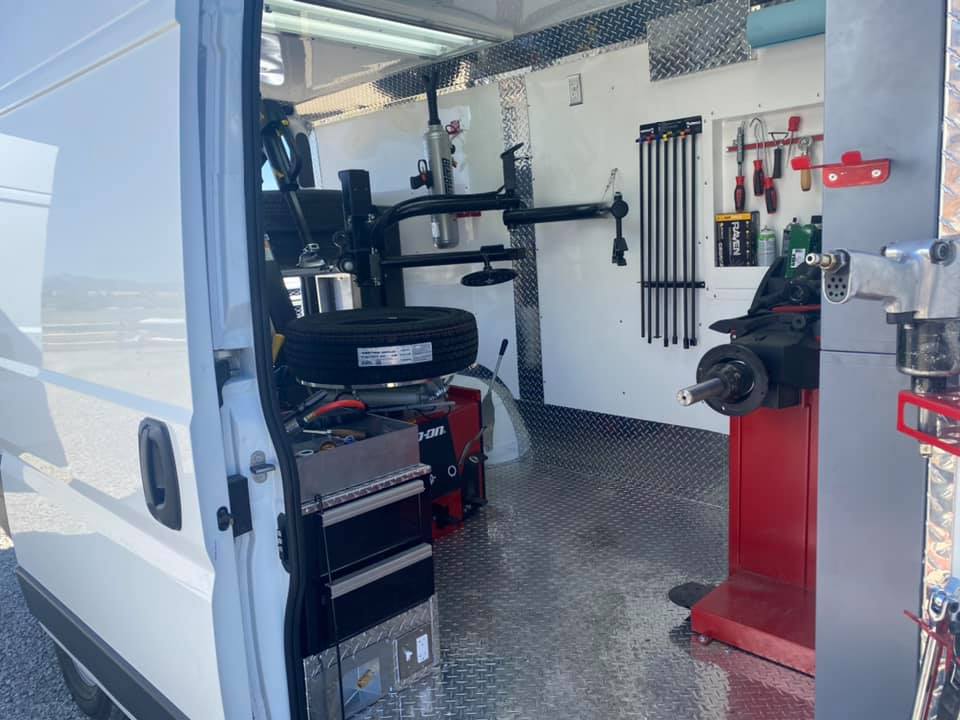Fast and Specialist Mobile Tire Repair Las Vegas Services
Fast and Specialist Mobile Tire Repair Las Vegas Services
Blog Article
Tire Service: Proven Approaches for Optimal Tire Maintenance and Care
Preserving optimal tire condition is vital for both safety and security and performance of any type of automobile. From ensuring correct tire pressure to normal turning and placement, there are tried and tested methods that can significantly extend the life expectancy of your tires and enhance overall driving experience. As we discover the intricacies of tire treatment and upkeep, we will discover essential guidelines that every lorry proprietor should stick to for the best feasible outcomes. Let's explore the world of tire service and discover the secrets to maintaining your tires in first-class form for the long run.
Value of Tire Pressure
Sufficient tire pressure promotes much better gas effectiveness, as under-inflated tires can lead to increased rolling resistance, causing the engine to function tougher and consume even more fuel. Proper tire pressure makes sure also step wear, boosting tire long life and saving money in the long run by postponing the requirement for premature replacements. Frequently readjusting and checking tire stress, specifically before lengthy trips, is a simple yet reliable way to enhance vehicle performance, expand tire life expectancy, and focus on security on the roadway.
Tire Rotation Guidelines
When considering tire turning standards, it is vital to understand the value of this maintenance job in making the most of tire lifespan and preserving ideal car efficiency. Tire rotation includes transforming the setting of each tire on an automobile to guarantee even step wear. Front tires have a tendency to use quicker than rear tires because of steering forces, making regular rotation essential for balanced wear patterns. The advised turning pattern varies relying on whether a lorry is front-wheel, rear-wheel, all-wheel, or 4x4. Usually, tires must be turned every 5,000 to 7,500 miles, or as encouraged in the automobile manual. Neglecting tire rotation can cause irregular wear, affecting handling, traction, and possibly compromising vehicle safety and security. By adhering to appropriate rotation guidelines, chauffeurs can prolong the life of their tires, boost fuel performance, and improve overall driving experience. Normal turning is a straightforward yet efficient maintenance method that adds dramatically to tire durability and automobile efficiency.

Benefits of Wheel Placement
Making certain appropriate wheel positioning after tire turning is crucial for preserving well balanced wear patterns and maximizing lorry performance. Wheel alignment refers to the modification of the angles of the wheels to the producer's specifications. One of the vital advantages of wheel placement is improved dealing with and steering response. When the wheels are correctly aligned, it reduces guiding effort, making certain a smoother and much more regulated driving experience. In addition, appropriate wheel placement aids to expand the lifespan of your tires. Misaligned wheels can cause irregular tire wear, resulting in early tire replacement and raised maintenance expenses.

Tire Tread Depth Inspect
Executing a normal evaluation of tire step depth is crucial for preserving secure driving problems and prolonging the life expectancy of your tires. Irregular walk wear can suggest concerns with tire stress, placement, or suspension, highlighting the value of regular tread depth like this checks. By incorporating tire tread deepness checks into your regular upkeep routine, you can drive with confidence knowing that your tires are in top problem.
Seasonal Tire Evaluation
Seasonal tire inspection is a fundamental aspect of tire maintenance that makes sure tires are prepared to face the obstacles postured by different climate problems. In prep work for wintertime, it is necessary to inspect the tire pressure frequently as chilly temperatures can cause tire pressure to go down. By conducting regular seasonal tire examinations, drivers can lengthen tire life-span, improve fuel effectiveness, and most significantly, guarantee a protected driving experience in varying weather problems.
Verdict
In final thought, preserving proper tire pressure, turning tires routinely, aligning wheels correctly, keeping an eye on tread deepness, and performing seasonal examinations are essential techniques for optimal tire care. By complying with these shown techniques, vehicle drivers can guarantee their tires last longer, do much better, and add to overall vehicle security. It top article is important to focus on tire maintenance to avoid accidents, improve fuel performance, and extend the life expectancy of tires.
Sufficient tire pressure promotes far better fuel efficiency, as under-inflated tires can lead to boosted rolling resistance, causing the engine to function harder and consume even more fuel.When considering tire rotation standards, it is crucial to understand the significance of this upkeep job in making the most of tire life expectancy and keeping ideal vehicle efficiency. Seasonal tire assessment is an essential element of tire upkeep that makes sure tires are ready to deal with the challenges posed by other various weather problems. By performing regular seasonal tire examinations, drivers can prolong tire life-span, improve gas performance, and most significantly, ensure a secure driving experience in differing weather condition conditions.
In final thought, preserving proper tire stress, rotating tires regularly, straightening wheels appropriately, monitoring step deepness, and performing seasonal evaluations are necessary techniques for optimum tire care.
Report this page